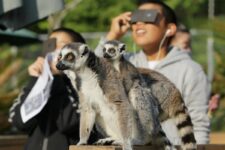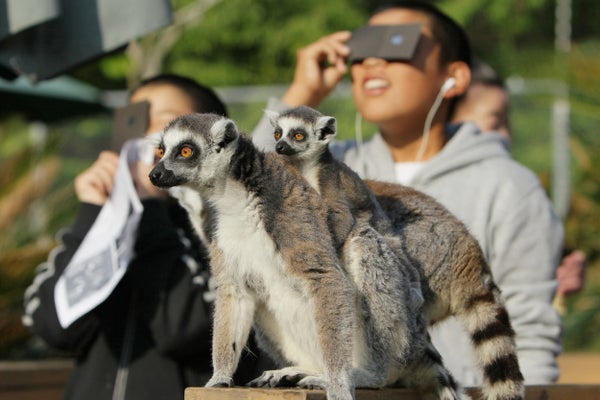
How Do Animals Respond to a Total Solar Eclipse?
How Do Animals Respond to a Total Solar Eclipse?
Scientists are finally getting their hands on enough data to begin to understand how animals react to a total solar eclipse

Ring-tailed lemurs look on as children view a solar eclipse at the Japan Monkey Center in Inuyama city in Aichi prefecture, central Japan, in May 2012.
JIJI Press/AFP via Getty Images
This article is part of a special report on the total solar eclipse that will be visible from parts of the U.S., Mexico and Canada on April 8, 2024.
Adam Hartstone-Rose had unusual company during 2017’s total solar eclipse: he watched the spectacle alongside 43 Rainbow and Coconut Lorikeets, that were tucked in their enclosure at the Riverbanks Zoo in South Carolina. As the moon blocked out the sun and twilight appeared to fall in midafternoon, an awe-filled experience for many humans, Hartstone-Rose observed his feathered friends’ more mundane reactions: the birds simply assumed that night had come and, minutes later, that morning had subsequently arrived.
“They did their entire evening routine and nighttime routine and morning routine, all in the span of about four minutes,” says Hartstone-Rose, a biologist now at North Carolina State University.
On supporting science journalism
If you’re enjoying this article, consider supporting our award-winning journalism by subscribing. By purchasing a subscription you are helping to ensure the future of impactful stories about the discoveries and ideas shaping our world today.
For centuries, people have been intrigued by animals’ odd behaviors during total eclipses, when the moon’s shadow sends a strip of Earth into an untimely twilight. “There have been lots of anecdotal stories and people who have tried to collect and understand how animals respond to eclipses over many, many years,” says Rebecca Johnson, a biologist at the California Academy of Sciences. People often tell stories of birds and insects making noise or falling silent, for example.
But gathering data that aren’t merely anecdotal is no easy task, she says. “It’s a pretty hard system to study because eclipses don’t happen that often,” Johnson says. On average, any given place on Earth sees a total solar eclipse just once every 375 years—hardly something to build a career around, Johnson says.
Fortunately, studying animals’ responses to totality, the point at which the moon completely covers the sun’s disk, has become much more feasible, thanks to the boom in crowdsourced science in recent decades—and the pure good fortune that 2017’s total solar eclipse crossed the U.S. coast-to-coast, allowing more than 200 million people to view it.
Hartstone-Rose’s lorikeet lounging was part of a limited eclipse study that included observations of 15 other species across the zoo. He and his colleagues were able to identify three main ways these animals responded to totality. Some, such as his lorikeet companions (Trichoglossus moluccanus and T. haematodus), displayed nighttime behaviors. Some animals showed behaviors that seemed to the observers to be rooted in anxiety, such as giraffes that began galloping around their enclosure. And some, such as grizzly bears (Ursus arctos horribilis), gave no apparent response.
A handful of animals didn’t seem to fall into any of these categories, Hartstone-Rose notes. “During the peak of the eclipse, [two of] the Galápagos tortoises [Chelonoidis nigra] started breeding,” Hartstone-Rose says. “I have no idea why that was.” All the tortoises in the enclosure gazed up at the sky after totality ended, he and his colleagues recounted in their paper.
Despite identifying these categories, the researchers didn’t see any patterns that might explain which species responded in what way, Hartstone-Rose says, although he noted they were only able to observe one nocturnal species. Among categories such as predators and prey and mammals and birds, there was no clear correlation to who acted blasé or upset or who called it a day a few hours early.
Johnson also worked on a project for the 2017 eclipse. The effort encouraged the public to submit observations via the iNaturalist app and received 2,750 reports about the responses of various species of animals and plants to both total and partial eclipse conditions. Many of these observations focused on common species—pet dogs and cats, domestic chickens and honeybees—although the researchers didn’t find any trends within or between observed species. (Indoor pets may have been unlikely to be fazed because they would have regularly experienced artificial lighting that got switched on and off.)
Buoyed by their 2017 successes, both Hartstone-Rose and Johnson have organized projects for the total solar eclipse that will pass across Mexico, the U.S. and Canada on April 8. Hartstone-Rose is headed to Fort Worth Zoo in Texas, where trained observers will monitor both species that he and his colleagues had watched in 2017 and new species. The scientists are also encouraging visitors to the zoo and people across the continent to submit their own reports of how animals respond to the eclipse. Meanwhile Johnson and her colleagues are again asking for observations through iNaturalist.
Researchers who are new to eclipse hunting are joining the endeavor as well. Kimberly Rosvall, an animal behavior scientist at Indiana University Bloomington, which will fall in the path of totality in the upcoming eclipse, is part of another team that is seeking observations of animals during the event from the surrounding community.
Rosvall says this eclipse is especially intriguing for her own field of study, birds, because it will occur in early April. Spring is a crucial season for migratory birds. During this time, the animals spend their nights migrating to breeding grounds, then scope out mates and nesting sites after they have arrived. “This is a really fascinating timing from a bird behavior perspective,” she says. “Those birds are setting up what’s essentially the most important period of their lives.”
Rosvall is interested not only in what birds do during the unexpected darkness but also in what they do next. “Will they treat it like it’s a new morning, like it’s 7 A.M.?” she says. “Or will they behave like it’s 3:30 P.M.?”
Whether you’ll be able to catch a partial eclipse or the marvel of totality this April, consider staying aware of the responses of animals—including yourself. For some people, the spectacle is unexpectedly striking.
“I really didn’t anticipate the eclipse being very interesting at all, and instead I’m now hooked,” Hartstone-Rose says. “I feel like I’m an eclipse groupie. I want to go and be under as many eclipses as I possibly can.”



